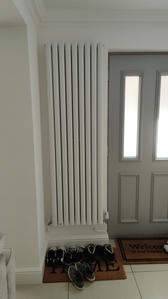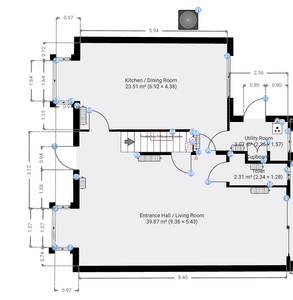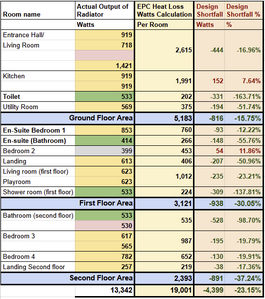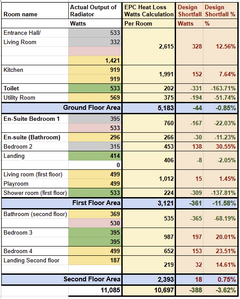Radiator Sizing Dilemma: Vertical vs Type 33 for Low-Temperature Heat Pump Systems
I’ve been working through hundreds of radiator options trying to finalise the design for my heat pump remedial work. My current “designer” radiators are underperforming by around 35% at a 50 °C flow, which obviously isn’t ideal for low-temperature systems. I’m aiming for a 45 °C flow, and anything lower would be amazing.
My main challenge is the kitchen, which only has two available wall spaces: one can take a 2200 × 1000 mm vertical radiator and the other a 2200 × 800 mm. Together, they need to cover a heat loss of roughly 2000 W. Which is proving difficult to achieve.
At the moment, I’m comparing Stelrad and Ultraheat models:
- I prefer Stelrad, as they’re MARC members, so their outputs should be more accurate.
- Ultraheat aren’t MARC certified, and their published outputs seem noticeably higher, even for similar radiator sizes, which makes me a bit sceptical.
Another concern is that I heard, that vertical radiators don’t perform as efficiently in practice, only the lower sections do the real work since they heat rising air, while the top half tends to do nothing.
Here’s what I’ve calculated and what my options are:
- Ultraheat 2000 × 600 Type 22: T50 = 11,419 BTU = 919 W → two units = 1838 W → shortfall = 162 W (≈ 8%)
- Stelrad 2000 × 700 Type 22: T50 = 10,246 BTU = 825 W → two units = 1650 W → shortfall = 350 W (≈ 17%)
- Ultraheat 900 × 1000 + 900 × 800 Type 33: 11,778 BTU + 9423 BTU = 21,201 BTU = 1991 W → shortfall = 284 W (≈ 14%)
So even with Type 33s, I’m still slightly under, but closer to target.
Would it make more sense to go with the 900 mm high Type 33s, rather than the tall 2000 mm Type 22 verticals? Would there be a better convective/output performance?
Posted by: @dreiWould it make more sense to go with the 900 mm high Type 33s, rather than the tall 2000 mm Type 22 verticals? Would there be a better convective/output performance?
Vertical rads are less effective per unit area, I assume (but dont know for certain) that they factor this into the quoted performance
Other than that I cant comment further, I think its as much a question of aesthetics as anything else. All of them are large so are going to make a significant impact both visually and on wallspace (which can matter in a kitchen!). Have you considered a fancoil. I faced a similar problem in the living half of a kitchen/living room and, after much agonising, ended up with a Mitsubishi Ilife2 slim fancoil. Expensive (but then so are type 33 rads) but worth it in the particular situation and, as it has its own thermostat, it will turn down (but without restricting flow or system volume) when the heat of cooking adds to the energy input to the room. In a kitchen kickspace heaters (which are fancoils) are also an option.
4kW peak of solar PV since 2011; EV and a 1930s house which has been partially renovated to improve its efficiency. 7kW Vaillant heat pump.
Posted by: @jamespaPosted by: @dreiWould it make more sense to go with the 900 mm high Type 33s, rather than the tall 2000 mm Type 22 verticals? Would there be a better convective/output performance?
Vertical rads are less effective per unit area, I assume (but dont know for certain) that they factor this into the quoted performance
Other than that I cant comment further, I think its as much a question of aesthetics as anything else. All of them are large so are going to make a significant impact both visually and on wallspace (which can matter in a kitchen!). Have you considered a fancoil. I faced a similar problem in the living half of a kitchen/living room and, after much agonising, ended up with a Mitsubishi Ilife2 slim fancoil. Expensive (but then so are type 33 rads) but worth it in the particular situation and, as it has its own thermostat, it will turn down (but without restricting flow or system volume) when the heat of cooking adds to the energy input to the room. In a kitchen kickspace heaters (which are fancoils) are also an option.
These sound the same as the Jaga units @downfield mentioned in another post. If they work then I am definitely tempted, issue is that I have no electrical connections anywhere near them.
This is what we have at the moment in the kitchen on the two walls, this one is located in the living room side, by the front door. I need a beefy replacement radiator for this one too, but wanted to look at the kitchen options first.
Large panel radiators are not going to look nice, but what choice do I have, if I want the heat output to cover the heat loss. Underfloor heating would have been great, if only the previous owner thought of it when he replaced the whole downstairs with marble flooring.
Thats a nice designer radiator which it would be a shame to bin, and the space is otherwise useless. That said vertical panel radiators dont look so bad, the strong vertical lines take over. There are also various aftermarket treatments including at least one which is a smart metal overlay in three forms, basically designed to make it look like a completely flat panel with or without a 'border'.
Whats the deficit (with the current rad) in watts as opposed to percentage and is it actually that significant given cooking, output from fridge etc. Is there any scope for a bit of 'import' from adjacent rooms. Is there any scope for additional insulation or an additional small rad.
In my utility room I had a similar conundrum and a similar (but narrower) designer radiator. I decided to take the risk that it would 'do' with the knowledge that, if necessary, a supplementary rad would fix up any deficit. The risk paid off.
4kW peak of solar PV since 2011; EV and a 1930s house which has been partially renovated to improve its efficiency. 7kW Vaillant heat pump.
@drei I’ve been working through hundreds of radiator options trying to finalise the design for my heat pump remedial work. My current “designer” radiators are underperforming by around 35% at a 50 °C flow, which obviously isn’t ideal for low-temperature systems. I’m aiming for a 45 °C flow, and anything lower would be amazing.
If you want work it out the easy way, this is what I did using a Heat Geek suggestion for approximate low flow temp output estimation.
1. Check the output of radiators at 50w flow temp - they all have this in the spec.
2. Find your heat loss for the room you are speccing and hunt for radiators you like with a much higher output.
3. Run the output number through this converter or similar
4. For a 40° flow temp you need to convert your 50w output to a Delta T of 20
5. Now look for a radiator output that surpasses your heat loss at the Delta T 20 figure.
This works as a method - I specced my entire system using it and it ran fine last winter. I don't like being cold.
Meanwhile, I bought this aluminium radiator for my bathroom it's extraordinary. It kicks out the heat at low flow temps. It doesn't even look like a 'normal radiator (it's got vertical fins at each end).They will custom colour them or you can buy them in ivory for quick delivery. I cannot recommend them enough for heat pumps and style.
Posted by: @jamespaThats a nice designer radiator which it would be a shame to bin, and the space is otherwise useless. That said vertical panel radiators dont look so bad, the strong vertical lines take over. There are also various aftermarket treatments including at least one which is a smart metal overlay in three forms, basically designed to make it look like a completely flat panel with or without a 'border'.
Whats the deficit (with the current rad) in watts as opposed to percentage and is it actually that significant given cooking, output from fridge etc. Is there any scope for a bit of 'import' from adjacent rooms. Is there any scope for additional insulation or an additional small rad.
In my utility room I had a similar conundrum and a similar (but narrower) designer radiator. I decided to take the risk that it would 'do' with the knowledge that, if necessary, a supplementary rad would fix up any deficit. The risk paid off.
Floor plans with radiator and heat pump locations and the doors stay open, the kitchen doors are kept about half way open, to allow the radiators behind them enough air flow, as those are the only two radiators.
Open Living Room Heat Loss = 2615 W - current rads output 1722 W
Kitchen Heat Loss = 1991 W - current rads output 1294 W
Toilet = 202 W - current rad output 138 W
Utility Room = 375 W - current rad output 356 W
And this is on 50c flow rate
As I am aiming for 45c minimum:
Open Living - vertical Stelrad K2, one 700 x 900 K3 by the stairs with another 700 x 2000 in the dining area and on the toilet wall, I could try going larger, but limited space due to electric main sockets, for a total of 2922 W
Kitchen - two vertical Stelard K2 for a total of 1650 W or I can go I can get the two large 900 mm K3s for a total of 1991 W bang on, but Ultraheat output may be slightly overstated.
Toilet - I was planning on reusing the 1800 mm designer radiator, as I can get a towel bar for it, so total of 515 W
Utility Room - one Stelrad 700 or Ultraheat 900 mm tall K3 for a total of 477 W OR 550 W
Sorry I think I understand but just to check....
Taking the kitchen as an example are you saying that the current actual loss is 1991 W and at 50C flow temp the current rads would output 1294 W?
I calculate the total loss of the downstairs rooms by adding up your figures as 5.2kW. The area is 69sq m - 75W/sq m. I cant remember what you said about the insulation level but my part improved (but by no means fully improved) 1930s house is 35W/sq m.
It sounds like you have a plan for the designer radiator so as long as you are happy with the chosen solution then it wont matter if they turn out to be oversized!
4kW peak of solar PV since 2011; EV and a 1930s house which has been partially renovated to improve its efficiency. 7kW Vaillant heat pump.
Posted by: @lucia@drei I’ve been working through hundreds of radiator options trying to finalise the design for my heat pump remedial work. My current “designer” radiators are underperforming by around 35% at a 50 °C flow, which obviously isn’t ideal for low-temperature systems. I’m aiming for a 45 °C flow, and anything lower would be amazing.
If you want work it out the easy way, this is what I did using a Heat Geek suggestion for approximate low flow temp output estimation.
1. Check the output of radiators at 50w flow temp - they all have this in the spec.
2. Find your heat loss for the room you are speccing and hunt for radiators you like with a much higher output.
3. Run the output number through this converter or similar
4. For a 40° flow temp you need to convert your 50w output to a Delta T of 20
5. Now look for a radiator output that surpasses your heat loss at the Delta T 20 figure.
This works as a method - I specced my entire system using it and it ran fine last winter. I don't like being cold.
Meanwhile, I bought this aluminium radiator for my bathroom it's extraordinary. It kicks out the heat at low flow temps. It doesn't even look like a 'normal radiator (it's got vertical fins at each end).They will custom colour them or you can buy them in ivory for quick delivery. I cannot recommend them enough for heat pumps and style.
I guess you didn't see my original post and the article 😋 😉. I have a pretty accurate maths formula that can churn out the real radiator W output, using desired room temperature and flow rate.
I went through pretty much every possible radiator combination, even looked at the more expensive aluminium ones, output is no different than the K2 and K3, sometimes much worse. That particular ones look nice but only does 356 W. Won't beat any of the 700 x 600 K3s which do 447 W.
Are there any advantages on Aluminium radiators? Because from what I heard, they are much more prone to galvanic corrosion in comparison to others, but have a fast heat-up and cool-down times, however on heat pumps the fast heating is irrelevant as this would only be relevant when you turn off/on your system.
Posted by: @jamespaSorry I think I understand but just to check....
Taking the kitchen as an example are you saying that the current actual loss is 1991 W and at 50C flow temp the current rads would output 1294 W?
I calculate the total loss of the downstairs rooms by adding up your figures as 5.2kW. The area is 69sq m - 75W/sq m. I cant remember what you said about the insulation level but my part improved (but by no means fully improved) 1930s house is 35W/sq m.
It sounds like you have a plan for the designer radiator so as long as you are happy with the chosen solution then it wont matter if they turn out to be oversized!
Yep that's it, but the current design would require either tall vertical 2000 or 2200 mm K2 rads, or larger 900 mm tall K3. I was just wondering which ones would be best to choose from a heating capability, I am concerned that the tall K2s look good on paper but won't allow for air flow thus less heat output. Honestly I only have these two options, just looking for best advice as either option won't be cheap.
At the moment, I am looking at around £6500 just in radiators, and another £8500 in labour, buffer, primary pump replacement/remedial work etc.
Posted by: @dreiI was just wondering which ones would be best to choose from a heating capability, I am concerned that the tall K2s look good on paper but won't allow for air flow thus less heat output. Honestly I only have these two options, just looking for best advice as either option won't be cheap.
I cant comment unfortunately. I did all my selection based on Stelrad figures on the basis that they seemed conservative and I assume that, in reality, all panel radiators are very similar.
I would consider the aesthetics, K3s (of which I have just one) appear much more chunky than K2s which of course can be good or bad depending on location/personal preference etc. Sometimes making a statement is just what is needed! In a kitchen you will have some waste heat anyway so if you are short of a few watts its unlikely to matter too much. Im assuming you have now ruled out a fancoil.
4kW peak of solar PV since 2011; EV and a 1930s house which has been partially renovated to improve its efficiency. 7kW Vaillant heat pump.
Posted by: @jamespaPosted by: @dreiI was just wondering which ones would be best to choose from a heating capability, I am concerned that the tall K2s look good on paper but won't allow for air flow thus less heat output. Honestly I only have these two options, just looking for best advice as either option won't be cheap.
I cant comment unfortunately. I did all my selection based on Stelrad figures on the basis that they seemed conservative and I assume that, in reality, all panel radiators are very similar.
I would consider the aesthetics, K3s (of which I have just one) appear much more chunky than K2s which of course can be good or bad depending on location/personal preference etc. Sometimes making a statement is just what is needed! In a kitchen you will have some waste heat anyway so if you are short of a few watts its unlikely to matter too much. Im assuming you have now ruled out a fancoil.
I would second this. It's great if you can balance radiator output exactly to the design heat loss for the room, but I wouldn't get too hung up about it. You will get heat transfer from adjoining rooms and there will be other sources of heat in some rooms (occupants, solar gain, cooking in kitchen etc). Looking at my radiator design spreadsheet, we are as much as +/-35% in some rooms and yet all rooms feel the same temperature. If you know you're going to be under in one space, try to over design a little in the adjoining spaces to compensate.
After we had our heat loss survey, we specced the largest Stelrad K2 radiators we could reasonably accommodate in each room, and plugged their output into a spreadsheet to see where we landed. We are 25% and 35% down in our two bathrooms (yet they don't feel cold), and as much as 35% up in one other room (which we probably could have reduced the radiator size a bit). But by going as large as possible in every room, we have been able to keep operating flow temps as low as possible and are able to run flow temps of 30-35C all year which is great for efficiency.
Samsung 12kW gen6 ASHP with 50L volumiser and all new large radiators. 7.2kWp solar (south facing), Tesla PW3 (13.5kW)
Solar generation completely offsets ASHP usage annually. We no longer burn ~1600L of kerosene annually.
Posted by: @old_scientistPosted by: @jamespaPosted by: @dreiI was just wondering which ones would be best to choose from a heating capability, I am concerned that the tall K2s look good on paper but won't allow for air flow thus less heat output. Honestly I only have these two options, just looking for best advice as either option won't be cheap.
I cant comment unfortunately. I did all my selection based on Stelrad figures on the basis that they seemed conservative and I assume that, in reality, all panel radiators are very similar.
I would consider the aesthetics, K3s (of which I have just one) appear much more chunky than K2s which of course can be good or bad depending on location/personal preference etc. Sometimes making a statement is just what is needed! In a kitchen you will have some waste heat anyway so if you are short of a few watts its unlikely to matter too much. Im assuming you have now ruled out a fancoil.
I would second this. It's great if you can balance radiator output exactly to the design heat loss for the room, but I wouldn't get too hung up about it. You will get heat transfer from adjoining rooms and there will be other sources of heat in some rooms (occupants, solar gain, cooking in kitchen etc). Looking at my radiator design spreadsheet, we are as much as +/-35% in some rooms and yet all rooms feel the same temperature. If you know you're going to be under in one space, try to over design a little in the adjoining spaces to compensate.
After we had our heat loss survey, we specced the largest Stelrad K2 radiators we could reasonably accommodate in each room, and plugged their output into a spreadsheet to see where we landed. We are 25% and 35% down in our two bathrooms (yet they don't feel cold), and as much as 35% up in one other room (which we probably could have reduced the radiator size a bit). But by going as large as possible in every room, we have been able to keep operating flow temps as low as possible and are able to run flow temps of 30-35C all year which is great for efficiency.
Would you say try and specc each room by around 10% to 20% uplift and if not possible make it up in other areas? With us, the whole house stays open, all the doors etc, except for the bedrooms at night which remain slightly ajar. I was thinking bedrooms no more than 15% maximum.
My issue with the bedrooms is that the kids tend to just kick off their covers/duvets and sleep like that, and if it gets a bit colder, I can see goose bumps on them, as I pop in and cover them, only for the duvet to be pushed aside after a while:)
This is my current workout with Panel Radiators:
This is my current workout with keeping as many existing designer radiators as possible, and only slapping in a 2m K3 in the living room:
The spreadsheet shows positive figures as the shortfall, in red, and the negative figures are green and good as these are higher than the existing heat loss. Hope it makes sense.
There is quite a substantial price difference between keeping existing radiators and replacing them, around £2500 more for the panels.
My main concern with keeping the existing, is that K-Rads may be inflating their Aspen radiators output, so my gains may be non-existent and I would still have a shortfall. This is from what I saw by comparing the Aspens VS similar looking MARC member radiators, like QS and the Omeara from UKRadiators.
- 26 Forums
- 2,342 Topics
- 53 K Posts
- 400 Online
- 6,000 Members
Join Us!
Worth Watching
Latest Posts
-
RE: Commencing on an ASHP Installation Process
I prepared this analysis for a post on another forum (a...
By Sheriff Fatman , 6 hours ago
-
RE: LiFePO4 lithium battery fires and explosions
Yes, more than an adjustment... This is the only comb...
By Batpred , 6 hours ago
-
RE: Poll for Time of Use, tariffs, technology
@old_scientist Interesting point, but I suspect that's ...
By Sheriff Fatman , 8 hours ago
-
RE: Different dT on each radiator?
I cant sorry. Its based on some calculations I did fro...
By JamesPa , 10 hours ago
-
RE: Setback savings - fact or fiction?
Maybe this: or maybe that the effect you are seein...
By JamesPa , 10 hours ago
-
RE: Help me keep the faith with my air source heat pump installation
@simonf thats interesting as I’ve noticed my flow and r...
By AdamK , 19 hours ago
-

RE: MELcloud scheduling misbehaviour
No, it gets to set temperature easily even during perio...
By Abernyte , 20 hours ago
-
RE: Free Ecoheat Heat Pump Install
Sorry hit 'add reply' too early, this forum layout will...
By Deltona , 20 hours ago
-
And arguably even more important, sodium will be hopefu...
By Batpred , 24 hours ago
-
RE: A Smarter Smart Controller from Homely?
I've been thinking of emailing Homely to ask for a few ...
By JohnnyB , 1 day ago
-
Max output of Heat pump (Daikin 4Kw EDLA04)
Hello, I am a bit puzzled that according to pcdb tes...
By GeorgeA , 2 days ago
-

In that case, @technogeek, I’d sign up for the free sol...
By Majordennisbloodnok , 2 days ago
-

RE: Has Anyone Else Noticed a Decline in Tradesmanship?
@cathoderay Hence my rider about ‘all else being equal’...
By Toodles , 2 days ago
-
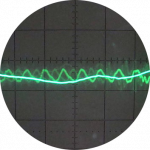
RE: Heat Pump Performance Analysis Web App using Modbus Data
@redzer_irl — all my heat pump data is in csv files, me...
By cathodeRay , 2 days ago
-

That’s not a problem. If you can hit the main landing p...
By Majordennisbloodnok , 2 days ago
-

RE: Configuration issues with 10kW Midea R32 heat pump
@benson I believe there are quite a few of these instal...
By Toodles , 2 days ago
-
RE: 10kw heat pump run in 24*7 data?
I would say you most likely do need 10kW. My gas consu...
By JamesPa , 2 days ago
-
RE: Mitsubishi Ecodan 11kw Defrosting Issue.
@thundermink I managed to find the fault. I did it a lo...
By meehow , 2 days ago

